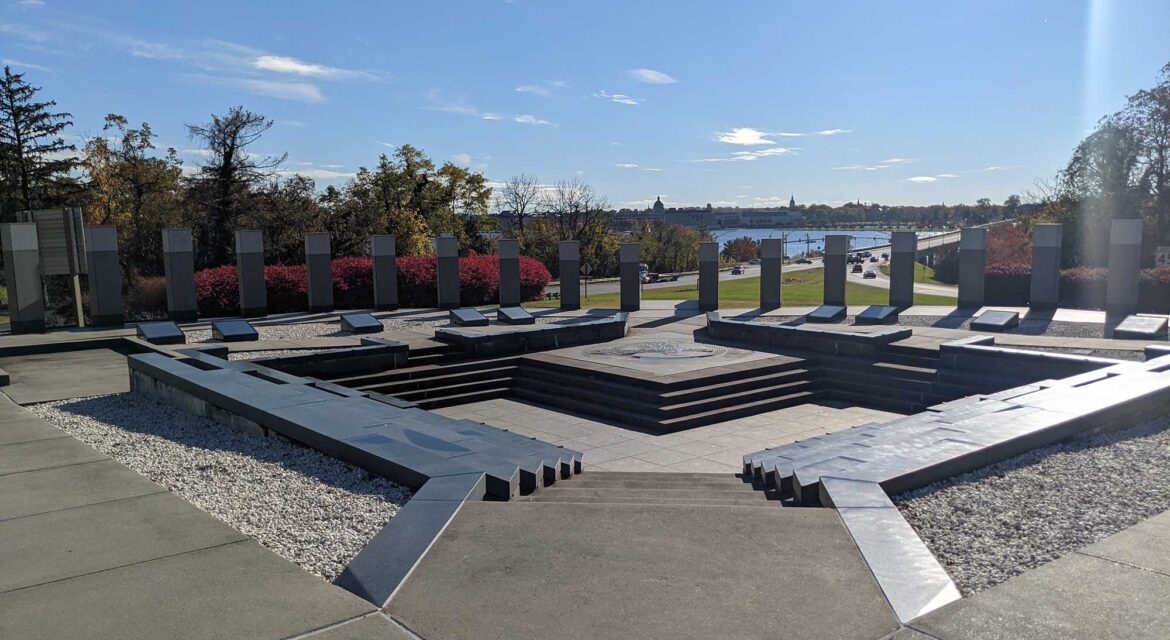 Located just outside downtown Annapolis, Maryland, the Maryland World War II Memorial is dedicated to all of the people from the area who gave their lives during World War II. Featuring the names of every Marylander who died during the war, the space has transformed what was otherwise an underutilized stretch of highway to enable connections in a way that resonates with multiple audiences and communities.
Located just outside downtown Annapolis, Maryland, the Maryland World War II Memorial is dedicated to all of the people from the area who gave their lives during World War II. Featuring the names of every Marylander who died during the war, the space has transformed what was otherwise an underutilized stretch of highway to enable connections in a way that resonates with multiple audiences and communities.

Honoring the 6,454 Marylanders Who Died in World War II
 Dedicated in 1998, the Maryland World War II Memorial was the culmination of a six-year process that began with the installation of a commission largely composed of veterans. Designed by Secundino Fernandez, the memorial features black stone panels with the names of the 6,454 Marylanders who died during the war along with various other tributes that commemorate the conflict. Various stone panels and circle mosaics both represent and illustrate Maryland’s role in the War.
Dedicated in 1998, the Maryland World War II Memorial was the culmination of a six-year process that began with the installation of a commission largely composed of veterans. Designed by Secundino Fernandez, the memorial features black stone panels with the names of the 6,454 Marylanders who died during the war along with various other tributes that commemorate the conflict. Various stone panels and circle mosaics both represent and illustrate Maryland’s role in the War.
Various other thematic connections to the history and legacy of the conflict and state can be seen across the memorial. An open-air amphitheater is surrounded by 48 upright stone pillars, representing the 48 states that were part of the United States at the time of World War II. A distinctive seven-sided obelisk is topped with the image of a star which is symbolic of Maryland as the seventh state to join what would become the United States of America. A small white stone memorial is dedicated to those who died at Pearl Harbor.
 The Governor Ritchie Scenic Overlook provides visitors with a space to look across the memorial and Annapolis, with a limestone cenotaph in the middle of the plaza. It is located along a busy four-lane highway in a suburban residential area. Dedicated in 1940, this overlook would provide the space and opportunity for the eventual creation of the Maryland World War II Memorial.
The Governor Ritchie Scenic Overlook provides visitors with a space to look across the memorial and Annapolis, with a limestone cenotaph in the middle of the plaza. It is located along a busy four-lane highway in a suburban residential area. Dedicated in 1940, this overlook would provide the space and opportunity for the eventual creation of the Maryland World War II Memorial.
The amphitheater of the Maryland World War II Memorial has ample seating and standing areas, providing the community and veterans with a space to gather for organized and impromptu events. This connection with the past and present of the community highlights the transformative power of the memorial which is set to define space and community into the far future.

Transforming the Space and Community
 Built on Route 450 overlooking the Severn River, the Maryland World War II Memorial is free and open every day. This lasting tribute to one of the formative events for the nation has positively transformed the space and community, showcasing what it can mean for a monument to enable connection and opportunity on multiple levels.
Built on Route 450 overlooking the Severn River, the Maryland World War II Memorial is free and open every day. This lasting tribute to one of the formative events for the nation has positively transformed the space and community, showcasing what it can mean for a monument to enable connection and opportunity on multiple levels.

